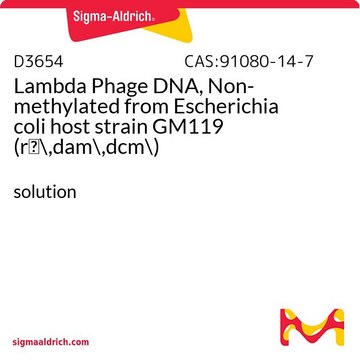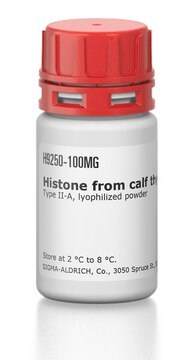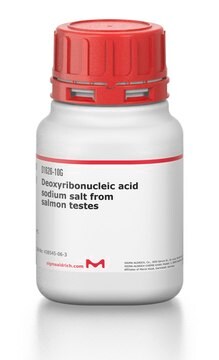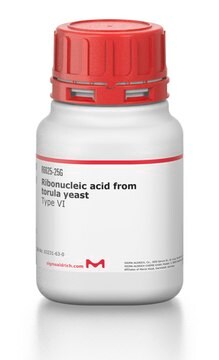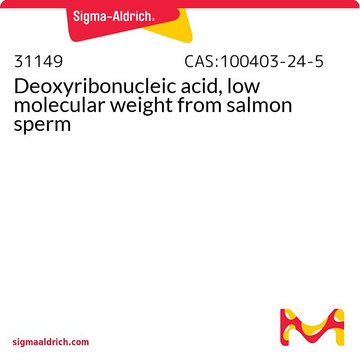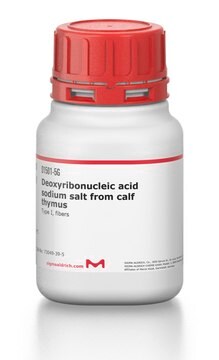Alle Fotos(1)
Wichtige Dokumente
D9768
Lambda Phage DNA, Methylated from Escherichia coli host strain W3110
lyophilized powder
Anmeldenzur Ansicht organisationsspezifischer und vertraglich vereinbarter Preise
Alle Fotos(1)
About This Item
Empfohlene Produkte
Qualität
for molecular biology
Qualitätsniveau
Form
lyophilized powder
Mol-Gew.
31.5 × 103 kDa
48 kb
Eignung
suitable for substrate for restriction endonucleases
Lagertemp.
2-8°C
Suchen Sie nach ähnlichen Produkten? Aufrufen Leitfaden zum Produktvergleich
Allgemeine Beschreibung
Phage DNA is isolated from infected E. coli, passed through a series of enzymatic steps before final phenol-chloroform extraction. This methylated lambda DNA is partially cleaved by Bcl I, Cla I, Mbo I, Mbo II, Taq I and Xba I.
Spezifität
Unique restriction sites: Apa I,Nae I, Nar I, Nhe I, PaeR7 I, SnaB I, Xba I and Xho I. Methylated lambda is partially cleaved by Bcl I, Cla I, Mbo I, Mbo II, Taq I and Xba I.
Anwendung
Lambda Phage DNA, Methylated from Escherichia coli host strain W3110 has been used in DNA combing to determine the conversion factor.
Lambda Phage DNA, Methylated from Escherichia coli host strain W3110 is suitable for use as a substrate for restriction enzymes. It was used for immunoprecipitation in ChIP assays.
The lambda phage has an icosahedral head and a long tail terminating in a single fiber. At both ends of the 5′ termini are complementary 12-nucleotide single strand sequences that contribute to the cohesive ends (cos region) of the DNA. The tail of the phage latches on the host outer membrane receptor and injects phage DNA into the cell. The phage converts the E. coli to a lysogenic state in which the phage functions are repressed and the phage genome may remain dormant (prophage) for a long time. This property is seen in bacteriophages that carry CII and CIII genes that are responsible for CI expression. Bacteriophages with CI mutation in the CI gene are able to maintain a lysogenic state at defined temperatures.
Infecting E. coli strain W3110 with lambda C1857 strain creates E. coli lysogen cultures. The phage is released from E. coli cell pellets by lysing with a high salt buffer, pH 8.0. The crude mixture is passed through a series of enzymatic steps, multiple cesium gradients, and phage DNA is dialyzed against 1 mM Tris-HCl, pH 8.0, and 1 mM magnesium chloride. The DNA is finally extracted by phenol-chloroform solution.
Infecting E. coli strain W3110 with lambda C1857 strain creates E. coli lysogen cultures. The phage is released from E. coli cell pellets by lysing with a high salt buffer, pH 8.0. The crude mixture is passed through a series of enzymatic steps, multiple cesium gradients, and phage DNA is dialyzed against 1 mM Tris-HCl, pH 8.0, and 1 mM magnesium chloride. The DNA is finally extracted by phenol-chloroform solution.
Einheitendefinition
One O.D. (A260) is approximately 50 μg of DNA
Rekonstituierung
Add the appropriate amount of 1x Tris-EDTA buffer, pH 8.0 (Product No. T9285, diluted to 1x, or comparable), to the vial.
Incubate the DNA sample vial at 65 °C for 4 hrs with frequent mixing.
After reconstitution, the product should be stored at -20 °C.
Incubate the DNA sample vial at 65 °C for 4 hrs with frequent mixing.
After reconstitution, the product should be stored at -20 °C.
Ähnliches Produkt
Lagerklassenschlüssel
11 - Combustible Solids
WGK
WGK 3
Flammpunkt (°F)
Not applicable
Flammpunkt (°C)
Not applicable
Persönliche Schutzausrüstung
Eyeshields, Gloves, type N95 (US)
Hier finden Sie alle aktuellen Versionen:
Besitzen Sie dieses Produkt bereits?
In der Dokumentenbibliothek finden Sie die Dokumentation zu den Produkten, die Sie kürzlich erworben haben.
Kunden haben sich ebenfalls angesehen
Analysis of replicating yeast chromosomes by DNA combing
Gallo D,et al.
Cold Spring Harbor Protocols, 2016(2), pdb-prot085118 (2016)
P Tran et al.
Physical review letters, 85(7), 1564-1567 (2000-09-06)
We have measured the conductivity sigma along the lambda phage DNA (lambda-DNA) double helix at microwave frequencies using lyophilized DNA in and also without a buffer. The conductivity is strongly temperature dependent around room temperature with a crossover to a
Alec M Desimone et al.
Molecular and cellular biology, 30(13), 3342-3356 (2010-05-05)
Switching between alternate states of gene transcription is fundamental to a multitude of cellular regulatory pathways, including those that govern differentiation. In spite of the progress in our understanding of such transitions in gene activity, a major unanswered question is
Unser Team von Wissenschaftlern verfügt über Erfahrung in allen Forschungsbereichen einschließlich Life Science, Materialwissenschaften, chemischer Synthese, Chromatographie, Analytik und vielen mehr..
Setzen Sie sich mit dem technischen Dienst in Verbindung.
